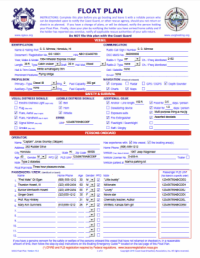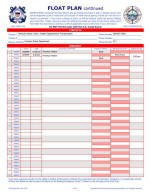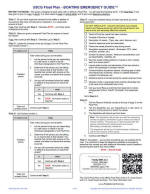|
|
|
|
| |
Home
|
|
| |
Previous
|
|
| |
|
|
| |
|
|
| |
|
|
| |
|
|
| |
|
|
| |
|
|
| |
|
|
| |
|
|
| |
|
|
| |
"Science is organized
knowledge. Wisdom is organized life." |
|
| |
Immanual Kant (1704-1824) |
|
| |
|
|
| |
|
|
| |
|
|
|

|
|
|
|
Home
>
About the Float Plan
> How it works
|
How it works
The USCG Float Plan is divided into six (6) major
sections each of which perform a specific
function, and are listed below in the order
they appear on each page of the
device:
|
PAGE
ONE |
| |
|
|
"Vessel" section
Contains critical details about your
vessel. The information is used to:
- Physically identify your vessel.
- Make contact with you.
- Determine the likelihood that
you will be able to find your way
back to shore should you have
drifted off course.
- Determine the ability of your
vessel to handle the environmental
conditions that have occurred, are
occurring, or will be occurring,
based on your itinerary.
"Safety & Survival" section
Helps rescue personnel further asses
the degree of severity of the incident
based on:
- The likelihood of you being able
to signal for help under the
prevailing environmental conditions.
- Your ability to protect yourself
and your crew from the environment.
"Persons On Board" section
Tells rescue personnel:
- The operators familiarity with
area and the vessel.
- How many people they need to
look for.
- Basic identifying
characteristics of each person.
- Information about the vehicle
used to transport the vessel and/or
passengers to the launch point.
- Any personal limitations that
may elevate the degree of severity
of the incident based on the time
and the prevailing environmental
conditions.
|
|
|
 |
|
|
USCG Float Plan
Page 1 |
|
|
PAGE TWO |
| |
|
|
"Contacts" section
Identifies three key contacts in the
event you do not check-in or returned as
planned:
- The initial contact point where
you began your voyage.
- The contact point at your
destination.
- Local rescue authority where you
began your voyage e.g. Police,
Sheriff or other first responder.
"Itinerary" section
Outlines your travel plans whether in or
out of the water, helping rescue
personnel determine the most likely area
to begin their search, based on:
- How long you've been missing
since your last "Check-in" time.
- Planned arrival and departure
dates and times.
- Mode of travel.
- Reason and location for any
planned stops.
|
|
|
 |
|
|
USCG Float Plan
Page 2 |
|
|
PAGE THREE |
| |
|
|
"Boating Emergency Guide™"
section
This exclusive guide provides
step-by-step instructions, for the
person holding your plan, on what to do
if they have a genuine concern for the
safety or welfare of the persons on
board, should you not "Check-in" or
return as planned:
- Requires no prior boating knowledge to use it effectively.
- Uses "Job Aid" technology to
guide and direct the person holding
you plan on what to do, when to do
it and how to do it.
|
|
|
 |
|
|
USCG Float Plan
Page 3 |
|
|
|
|
|
